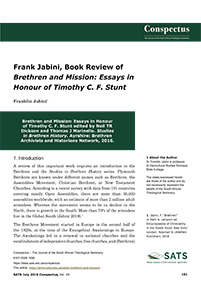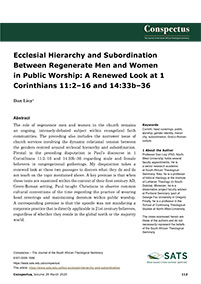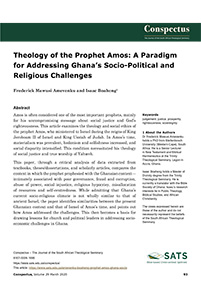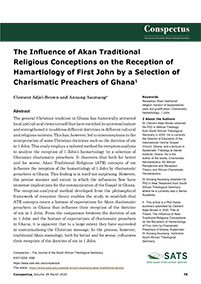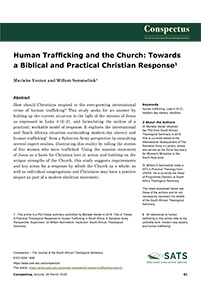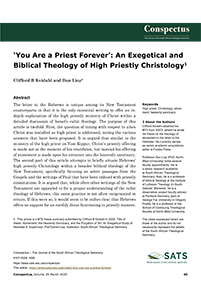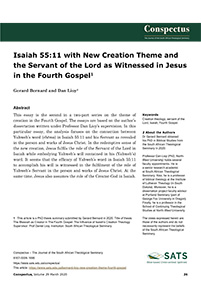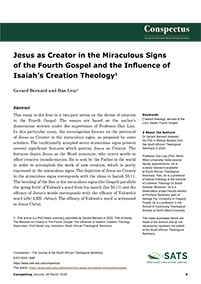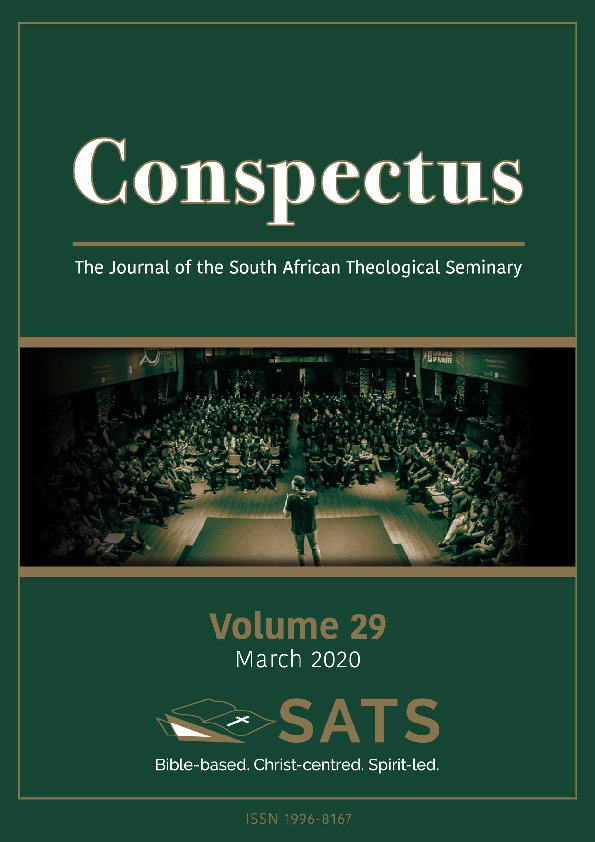Volume 29
March 2020
Frank Jabini, Book Review of Brethren and Mission: Essays in Honour of Timothy C. F. Stunt
A review of this important work requires an introduction to the Brethren and the Studies in Brethren History series. Plymouth Brethren are known under different names such as Brethren, the Assemblies Movement, Christian Brethren, or New Testament Churches. According to a recent survey with data from 101 countries covering mostly Open Assemblies, there are more than 30,000 assemblies worldwide, with an estimate of more than 2 million adult attendees. Whereas the movement seems to be in decline in the North, there is growth in the South. More than 70% of the attendees live in the Global South (Jabini 2018).
The Curious Case of Apphia, our Sister
Keywords: Apphia; Philemon; Paul; Wirkungsgeschichte; deliberative rhetoric.
Mentioned once in a letter about a slave called Onesimus and a paterfamilias called Philemon, Apphia remains an enigmatic figure that makes a sudden appearance in Philemon’s opening, and in the broader New Testament (NT). While her sole reference may appear disconnected from the epistle’s rhetorical emphases, the deliberative role played by both her presence in a prominent part of the epistle and her gender should not be understated. Contrastingly, the limited description accompanying her textual location among a group of men, who make multiple appearances in the broader Pauline corpus (cf. Phlm 23–24; Col 1:7–8, 4:7–17; 2 Tim 4:10)3 presents to the reader a peculiarity that has not gone unnoticed. It is into this space that this essay voyages as it explores Apphia’s inclusion from both historical and rhetorical shores. First, we locate Apphia as a character standing in continuity with other female personalities in the broader Pauline corpus. A brief treatment of her fictive kin, in the non-disputed and so-called ‘disputed’ letters, is undertaken to elucidate her pride of place in what is essentially Paul’s promissory note to Philemon (cf. Phlm 17). Second, the Wirkungsgeschichte of Philemon, vis-à-vis Apphia, is given due attention demonstrating the divergent interpretive preferences and the social forces behind them, where appropriate. Third, a (re)imagination of the various renderings of this figure, for the Global South, converges Philemon’s opening with a new hermeneutical horizon in which an epistolary salutation serves as a harbinger of universal equity in the new society. Arguably, such a vision underscores Paul’s revolutionary egalitarian ethic (cf. Gal 3:28, 1 Cor 12:12–13), moving the conversation to a new norm in which Apphia’s social location—as an equal among the brothers reverberates across a host of interpretive frequencies.Ecclesial Hierarchy and Subordination Between Regenerate Men and Women in Public Worship: A Renewed Look at 1 Corinthians 11:2–16 and 14:33b–36
Keywords: Corinth; head coverings; public worship; gender identity; hierarchy; subordination; Greco-Roman culture.
Among researchers well-versed on Paul’s theology concerning men and women, 1 Corinthians 11:2–16 and 14:33b–36 remain an ongoing source of controversy. The following essay, being aware of the dissonant and competing perspectives on these two disputed passages, seeks to contribute to the dialogue from the perspective of a confessional Lutheran who lives in the global north.2 This includes affirming that God created all people to be equal in dignity and worth, yet distinct as male and female in his sacred presence.Theology of the Prophet Amos: A Paradigm for Addressing Ghana’s Socio-Political and Religious Challenges
Keywords: judgement; justice; prosperity; righteousness; sovereignty.
Positively, the history of ancient Israel in the 8th century BCE was characterized by peace and economic growth and consolidation. This positive situation, however, affected Israel negatively as the people forgot their roots and did what they liked. Israel, as we shall discuss shortly, began to bear the common fruits of prosperity— pride, luxury, selfishness, and oppression. Sunukjian (1983:1425) describes Israel’s situation as follows: Commerce thrived (8:5), an upper class emerged (4:1–3), and expensive homes were built (3:15; 5:11; 6:4, 11).
The rich enjoyed an indolent, indulgent lifestyle (6:1–6), while the poor became targets for legal and economic
exploitation (2:6–7; 5:7, 10–13; 6:12; 8:4–6). Slavery for debt was easily accepted (2:6; 8:6). Standards of morality had sunk to a low ebb (2:7).The Influence of Akan Traditional Religious Conceptions on the Reception of Hamartiology of First John by a Selection of Charismatic Preachers of Ghana
Keywords: Reception; Akan traditional religion; horizon of expectations; uses and gratification; Charismatic; hamartiology; 1 John.
Christian tradition in Ghana has attracted to itself local and cultural views that have enriched its universal nature and strengthened it to address different doctrines of the Bible. This enrichment serves as the undercurrents for the current stream of historically younger Pentecostal independent or charismatic churches. Vicariously, they possess intrinsic characteristics that are the product of cultural influences. This has sometimes led to their failure to adequately analyse, understand, and express some Christian doctrines such as the doctrine of sin.Human Trafficking and the Church: Towards a Biblical and Practical Christian Response
Keywords: human trafficking; Luke 4:16–21; modern-day slavery; abolition.
Maria: She stands on a street corner, scantily dressed on a cold Johannesburg winter evening. Her eyes scan the passing traffic and she is not keen to engage in conversation, although she seems grateful for the hot cup of coffee offered to her by a street worker. Maria is a commercial sex worker in the South of Johannesburg. She has a pimp and lives in a brothel. She was offered a job in Johannesburg via a niece, and travelled to Johannesburg alone, against the advice of her parents. Once in the city, she discovered that the nature of the ‘job’ was prostitution. She cannot leave because she does not have enough money to pay the fare home, and because she is addicted to drugs and needs the daily ‘fix’ they provide.‘You Are a Priest Forever’: An Exegetical and Biblical Theology of High Priestly Christology
Keywords: High priest, Christology, atonement, heavenly sanctuary.
One of the most important contributions the letter to the Hebrews offers with respect to Christology is its unique emphasis on the high priesthood of Christ. No other New Testament writing offers such a descriptive picture of Christ’s installation as high priest, his process of perfection, or his entry into the heavenly sanctuary and subsequent offering for sin. Overall, Hebrews provides the most vivid picture of Christ’s high priesthood ministry in action, one that follows the movement of the Levitical high priest on Yom Kippur rather closely. This article will explore the high priestly Christology of Hebrews, specifically as it relates to the death, resurrection, and ascension of Christ into the heavenly sanctuary. Each of these aspects plays an important role in shaping Hebrews’ discussion of priesthood, while the language of ascension takes precedence in Hebrews.Isaiah 55:11 with New Creation Theme and the Servant of the Lord as Witnessed in Jesus in the Fourth Gospel
Keywords: Creation theology; servant of the Lord; Isaiah; Fourth Gospel.
The Fourth Gospel portrays Jesus Christ as the incarnation of the Creator-Word. In the incarnation, Jesus seems to be fulfilling the role of the Servant of the Lord in Isaiah, particularly as described in Isaiah 42:1–9. While fulfilling the Servant’s role, Jesus is also seen as embodying Yahweh’s word (rhēma), which contains his (Yahweh’s) creative will, in Isaiah 55:11. In other words, the efficacy of Yahweh’s rhēma in the new creation is witnessed in Jesus Christ
and his works. Thus a connection occurs between Yahweh’s rhēma in Isaiah 55:11 and the description of Yahweh’s Servant in Isaiah 42.Jesus as Creator in the Miraculous Signs of the Fourth Gospel and the Influence of Isaiah’s Creation Theology
Keywords: Creation theology; servant of the Lord; Isaiah; Fourth Gospel.
The Fourth Gospel presents the theme of creation right from the beginning of the Gospel (John 1:1–3, 10). The prologue alludes to the Genesis creation narrative when it opens with the phrase ‘in the beginning’ (en archē), resembling Genesis 1:1 LXX. It explicitly mentions the Word (logos), identified as Jesus (1:14–18), as the Agent of creation who has come into the world he created. Since the prologue serves ‘as an entry point in which key themes are broached and woven together in a liturgical celebration of the advent of the divine Word’ (Lioy 2005:57; cf. Carson 1991:111; Coloe 2011:2; Köstenberger 2009:176; Kruse 2003:20; Lindars 1972:81; Marshall 1982, 2:1082), it is assumed that the theme of creation also appears in the rest of the Gospel. Consequently, some interpreters have
identified the theme of creation in the ‘signs’ (sēmeia), which John depicts in the first half of his Gospel (chapters 2–12) (e.g. Brown 2010:286–288; Moore 2013; Rae 2008:302–308). In conjunction with the theme, Jesus is also portrayed as Creator in the miraculous signs.
